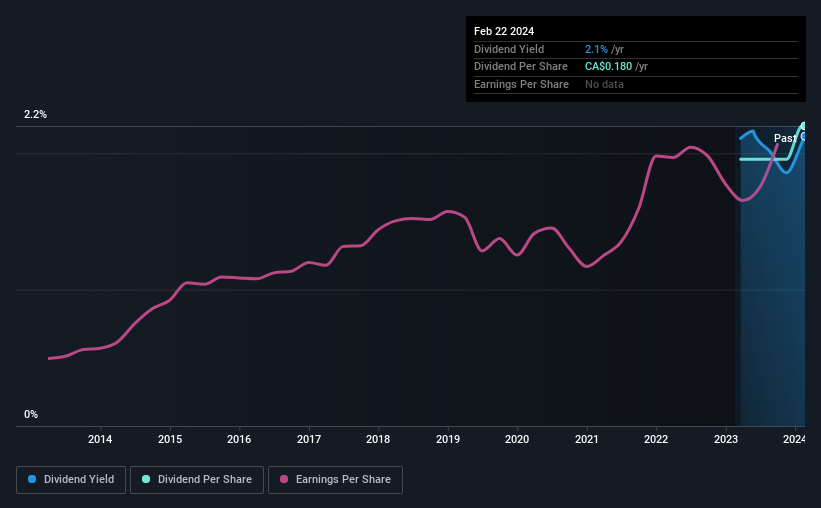Why You Might Be Interested In BioSyent Inc. (CVE:RX) For Its Upcoming Dividend
Regular readers will know that we love our dividends at Simply Wall St, which is why it's exciting to see BioSyent Inc. (CVE:RX) is about to trade ex-dividend in the next 4 days. The ex-dividend date is one business day before a company's record date, which is the date on which the company determines which shareholders are entitled to receive a dividend. The ex-dividend date is important because any transaction on a stock needs to have been settled before the record date in order to be eligible for a dividend. This means that investors who purchase BioSyent's shares on or after the 28th of February will not receive the dividend, which will be paid on the 15th of March.
The company's upcoming dividend is CA$0.045 a share, following on from the last 12 months, when the company distributed a total of CA$0.16 per share to shareholders. Calculating the last year's worth of payments shows that BioSyent has a trailing yield of 2.1% on the current share price of CA$8.47. Dividends are an important source of income to many shareholders, but the health of the business is crucial to maintaining those dividends. So we need to check whether the dividend payments are covered, and if earnings are growing.
View our latest analysis for BioSyent
Dividends are typically paid out of company income, so if a company pays out more than it earned, its dividend is usually at a higher risk of being cut. BioSyent paid out a comfortable 31% of its profit last year. A useful secondary check can be to evaluate whether BioSyent generated enough free cash flow to afford its dividend. Fortunately, it paid out only 31% of its free cash flow in the past year.
It's positive to see that BioSyent's dividend is covered by both profits and cash flow, since this is generally a sign that the dividend is sustainable, and a lower payout ratio usually suggests a greater margin of safety before the dividend gets cut.
Click here to see how much of its profit BioSyent paid out over the last 12 months.
Have Earnings And Dividends Been Growing?
Businesses with strong growth prospects usually make the best dividend payers, because it's easier to grow dividends when earnings per share are improving. If business enters a downturn and the dividend is cut, the company could see its value fall precipitously. This is why it's a relief to see BioSyent earnings per share are up 8.2% per annum over the last five years. Management have been reinvested more than half of the company's earnings within the business, and the company has been able to grow earnings with this retained capital. We think this is generally an attractive combination, as dividends can grow through a combination of earnings growth and or a higher payout ratio over time.
Unfortunately BioSyent has only been paying a dividend for a year or so, so there's not much of a history to draw insight from.
To Sum It Up
Is BioSyent an attractive dividend stock, or better left on the shelf? Earnings per share growth has been growing somewhat, and BioSyent is paying out less than half its earnings and cash flow as dividends. This is interesting for a few reasons, as it suggests management may be reinvesting heavily in the business, but it also provides room to increase the dividend in time. We would prefer to see earnings growing faster, but the best dividend stocks over the long term typically combine significant earnings per share growth with a low payout ratio, and BioSyent is halfway there. It's a promising combination that should mark this company worthy of closer attention.
So while BioSyent looks good from a dividend perspective, it's always worthwhile being up to date with the risks involved in this stock. For example - BioSyent has 3 warning signs we think you should be aware of.
Generally, we wouldn't recommend just buying the first dividend stock you see. Here's a curated list of interesting stocks that are strong dividend payers.
Have feedback on this article? Concerned about the content? Get in touch with us directly. Alternatively, email editorial-team (at) simplywallst.com.
This article by Simply Wall St is general in nature. We provide commentary based on historical data and analyst forecasts only using an unbiased methodology and our articles are not intended to be financial advice. It does not constitute a recommendation to buy or sell any stock, and does not take account of your objectives, or your financial situation. We aim to bring you long-term focused analysis driven by fundamental data. Note that our analysis may not factor in the latest price-sensitive company announcements or qualitative material. Simply Wall St has no position in any stocks mentioned.

 Yahoo Finance
Yahoo Finance 
